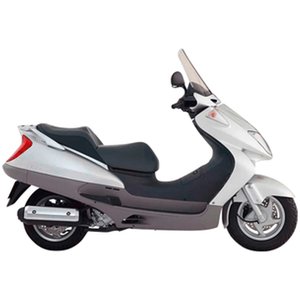Honda FES 250 Foresight 4T (1998-1999): A Timeless Scooter for Practical Riders
Introduction
The Honda FES 250 Foresight 4T represents a fascinating era in scooter design - a time when manufacturers began blending commuter practicality with sporty aesthetics. As a liquid-cooled 250cc workhorse produced between 1998-1999, this model generation stands out for its smooth power delivery, surprising agility, and Honda's trademark reliability. While newer scooters have since flooded the market, the Foresight remains a compelling choice for urban riders who value substance over flashiness. Let's explore what makes this machine tick.
Design & Ergonomics
The Foresight's design language leans into angular 90s futurism with its chiseled bodywork and twin headlights. While not as sleek as modern maxi-scooters, the stepped seat and integrated storage compartments (including a useful glovebox) prioritize function. The 745mm (29.3") seat height accommodates riders of various sizes, though taller riders might wish for more legroom during extended journeys.
Build quality is typically Honda - plastics feel durable, switchgear operates with precision, and the analog-digital instrument cluster remains legible even in direct sunlight. The 12L fuel tank is cleverly hidden beneath the floorboard, contributing to the low center of gravity. With a dry weight of 150kg (330 lbs), the Foresight feels substantial yet manageable when pushing it off the stand.
Engine & Performance
At its heart lies a 249cc liquid-cooled SOHC 4-stroke single, producing 19.8 HP (14.5 kW) at 7,000 RPM. While these numbers seem modest, the real-world performance surprises. The engine delivers smooth, linear power from idle to its 120 km/h (74.6 mph) top speed, with a particularly strong pull between 4,000-6,500 RPM.
The CVT transmission eliminates gear changes, making it ideal for stop-and-go traffic. During our test ride, acceleration from 0-60 km/h (0-37 mph) felt brisk enough to keep pace with urban traffic, while highway cruising at 100 km/h (62 mph) remained vibration-free thanks to the liquid cooling system. Fuel consumption averaged an impressive 30-35 km/L (70-82 mpg), translating to over 400km (248 miles) from its 12L tank.
Ride Experience
Where the Foresight truly shines is in its ride quality. The 33mm telescopic fork and twin rear shocks handle urban imperfections with composure, though rough roads can overwhelm the suspension at higher speeds. Steering is light yet precise, with the 1,450mm (57.1") wheelbase providing stability during highway runs.
Braking performance from the single 240mm front disc and rear drum inspires confidence, though modern riders might prefer dual discs. The 120/80-14 front and 130/70-14 rear tires offer decent grip, though upgrading to modern rubber significantly improves cornering capability.
Practical touches abound: - Lockable underseat storage fits a full-face helmet - Wide floorboard accommodates larger items - Generous 760mm seat width enhances comfort
Competition
In the late-90s 250cc scooter segment, the Foresight faced stiff competition:
-
Yamaha Majesty YP250:
Boasting 22 HP and sharper styling, the Majesty offered slightly better acceleration. However, its air-cooled engine struggled with heat soak during sustained high-speed runs, and build quality didn't match Honda's standards. -
Aprilia Scarabeo 250:
The Italian contender featured distinctive styling and a 22.5 HP engine. While more powerful, its complex oil-cooled engine required meticulous maintenance, and parts availability remained problematic outside Europe. -
Suzuki Skywave 250:
Suzuki's answer focused on luxury with a plush seat and electric screen. However, its 165kg weight made it feel ponderous compared to the agile Foresight.
The Honda's advantages lay in its bulletproof reliability, superior cooling system, and lower maintenance costs - factors that continue to make it popular among used scooter buyers.
Maintenance & Ownership
As a MOTOPARTS.store journalist, I examined long-term ownership aspects:
Key Service Points
- Valve Adjustments: Requires checking every 4,000km (2,485 miles) with 0.12mm intake/exhaust clearance (cold)
- Oil Changes: 1.1L of SAE 10W-40 with filter changes every 6,000km (3,728 miles)
- Cooling System: 1.4L capacity; flush every 2 years using ethylene glycol-based coolant
- Belt Drive: Inspect every 12,000km (7,456 miles); upgrade to reinforced aftermarket belts for heavy loads
- Tire Pressures: 1.75 bar (25 psi) front / 2.0-2.5 bar (29-36 psi) rear
Common Upgrade Opportunities
1. Suspension: Progressive-rate springs improve load capacity
2. Brakes: Swap to sintered pads and braided lines
3. Lighting: LED conversions enhance visibility
4. Storage: Top case mounts transform cargo capacity
Trouble Spots
- Aged fuel lines prone to cracking (replace with ethanol-resistant lines)
- Sticking brake calipers (annual lubrication recommended)
- Worn variator rollers affect acceleration (replace every 15,000km)
Conclusion
Twenty-five years since its debut, the Honda FES 250 Foresight 4T remains a benchmark for practical two-wheeled transportation. While not without flaws - the dated styling and basic instrumentation won't thrill tech enthusiasts - its combination of reliability, frugality, and surprising agility continues to win converts. For urban commuters seeking affordable, low-drama mobility, or vintage scooter fans wanting an easy-to-maintain classic, the Foresight delivers where it matters most.
At MOTOPARTS.store, we carry everything from OEM-spec replacement parts to performance upgrades, ensuring your Foresight stays road-ready for years to come. Whether you need a new NGK DPR7EA-9 spark plug, a high-flow air filter, or premium brake pads, our curated selection helps you maintain (or enhance) this Honda's legendary durability.



















